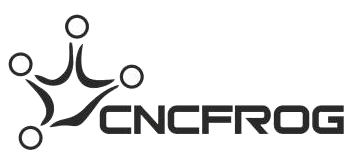We present a list of materials that can be cut and milled with the CNC Frog.
1. Polystyrene (PS) is a synthetic aromatic hydrocarbon polymer made from the monomer known as styrene.[5] Polystyrene can be solid or foamed. General-purpose polystyrene is clear, hard, and rather brittle. It is an inexpensive resin per unit weight. It is a rather poor barrier to oxygen and water vapour and has a relatively low melting point.[6] Polystyrene is one of the most widely used plastics, the scale of its production being several million tonnes per year.[7] Polystyrene can be naturally transparent, but can be coloured with colourants. Uses include protective packaging (such as packing peanuts and in the jewel cases used for storage of optical discs such as CDs and occasionally DVDs), containers, lids, bottles, trays, tumblers, disposable cutlery[6] and in the making of models. https://en.wikipedia.org/wiki/Polystyrene
2. Expanded polystyrene (EPS) is a rigid and tough, closed-cell foam with a normal density range of 11 to 32 kg/m3.[39] It is usually white and made of pre-expanded polystyrene beads. The manufacturing process for EPS conventionally begins with the creation of small polystyrene beads. Styrene monomers (and potentially other additives) are suspended in water, where they undergo free-radical addition polymerization. The polystyrene beads formed by this mechanism may have an average diameter of around 200 μm. The beads are then permeated with a “blowing agent”, a material that enables the beads to be expanded. Pentane is commonly used as the blowing agent. The beads are added to a continuously agitated reactor with the blowing agent, among other additives, and the blowing agent seeps into pores within each bead.
3. ABS is a terpolymer made by polymerizing styrene and acrylonitrile in the presence of polybutadiene. The proportions can vary from 15% to 35% acrylonitrile, 5% to 30% butadiene and 40% to 60% styrene. The result is a long chain of polybutadiene criss-crossed with shorter chains of poly(styrene-co-acrylonitrile). The nitrile groups from neighboring chains, being polar, attract each other and bind the chains together, making ABS stronger than pure polystyrene. The acrylonitrile also contributes chemical resistance, fatigue resistance, hardness, and rigidity, while increasing the heat deflection temperature. The styrene gives the plastic a shiny, impervious surface, as well as hardness, rigidity, and improved processing ease. The polybutadiene, a rubbery substance, provides toughness and ductility at low temperatures, at the cost of heat resistance and rigidity.[3] For the majority of applications, ABS can be used between −20 and 80 °C (−4 and 176 °F), as its mechanical properties vary with temperature.[5] The properties are created by rubber toughening, where fine particles of elastomer are distributed throughout the rigid matrix. https://en.wikipedia.org/wiki/Acrylonitrile_butadiene_styrene
4. Polyethylene or polythene (abbreviated PE; IUPAC name polyethene or poly(methylene)) is the most common plastic in use today. It is a polymer, primarily used for packaging (plastic bags, plastic films, geomembranes, containers including bottles, etc.). As of 2017, over 100 million tonnes of polyethylene resins are being produced annually, accounting for 34% of the total plastics market. https://en.wikipedia.org/wiki/Polyethylene
5. Polypropylene (PP), also known as polypropene, is a thermoplastic polymer used in a wide variety of applications. It is produced via chain-growth polymerization from the monomer propylene. Polypropylene belongs to the group of polyolefins and is partially crystalline and non-polar. Its properties are similar to polyethylene, but it is slightly harder and more heat resistant. It is a white, mechanically rugged material and has a high chemical resistance. https://en.wikipedia.org/wiki/Polypropylene
6. Polyvinyl chloride (colloquial: polyvinyl, vinyl; abbreviated: PVC) is the world’s third-most widely produced synthetic plastic polymer (after polyethylene and polypropylene). About 40 million tons of PVC are produced each year. PVC comes in two basic forms: rigid (sometimes abbreviated as RPVC) and flexible. The rigid form of PVC is used in construction for pipe and in profile applications such as doors and windows. It is also used in making bottles, non-food packaging, food-covering sheets, and cards (such as bank or membership cards). It can be made softer and more flexible by the addition of plasticizers, the most widely used being phthalates. In this form, it is also used in plumbing, electrical cable insulation, imitation leather, flooring, signage, phonograph records,[8] inflatable products, and many applications where it replaces rubber.[9] With cotton or linen, it is used in the production of canvas. https://en.wikipedia.org/wiki/Polyvinyl_chloride
7. Polycarbonates (PC) are a group of thermoplastic polymers containing carbonate groups in their chemical structures. Polycarbonates used in engineering are strong, tough materials, and some grades are optically transparent. They are easily worked, molded, and thermoformed. Because of these properties, polycarbonates find many applications. https://en.wikipedia.org/wiki/Polycarbonate
8. Dibond. A sandwich panel is any structure made of three layers: a low-density core, and a thin skin-layer bonded to each side. Sandwich panels are used in applications where a combination of high structural rigidity and low weight is required. https://en.wikipedia.org/wiki/Sandwich_panel
9. And even carbon and non-ferrous metals (aluminum, brass or copper), wood, cork, MDF,. etc.

